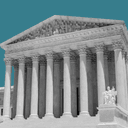
Professor Stephen Vladeck
Photo credit: Larry D. Moore, CC BY 4.0, Wikimedia Commons.
In this month’s episode of Discussions with DPIC, Executive Director Robin Maher speaks with Steve Vladeck, a Georgetown law professor and expert on the Supreme Court. Professor Vladeck is the author of The Shadow Docket: How the Supreme Court Uses Stealth Rulings to Amass Power and Undermine the Republic, released in 2023, as well as the weekly newsletter One First, which breaks down the Court’s rulings and history. Professor Vladeck explains why the Court’s treatment of death penalty cases has recently changed, the role the Court played in creating many of the problems with death penalty cases it now complains about, and how the death penalty shaped the Court’s new orientation and approach to other areas of law.
Professor Vladeck identifies Gregg v. Georgia (1976), in which the Supreme Court authorized the return of the death penalty by approving new capital statutes, as a catalyst for “massive changes” in the Court’s behavior. He explains that Gregg set many new rules around capital punishment that had to be litigated, prompting a flow of appeals from prisoners facing execution. While for many years the justices appeared open to these appeals and took the constitutional claims raised in them seriously, Professor Vladeck argues that since the departure of Justice Anthony Kennedy in 2018, the Court shifted “almost overnight” to disfavor reviewing the appeals of death-sentenced prisoners. “This is a Court that is just done for the most part…with emergency interventions in capital cases, and even really for the most part, with any special constitutional constraints on capital cases,” he says.
Professor Vladeck notes that the Court’s rulings since 2018 have essentially created a “presumption against emergency relief in capital cases,” making it nearly impossible for death-sentenced prisoners to obtain a stay of execution even with significant constitutional concerns. In his view, that presumption “makes no sense because it is based on the idea that it’s always the prisoner’s fault,” which is “just not factually true.” The Court was responsible for “creating those claims, and…creating a series of procedural rules that actually made it harder to bring those claims, except in those truncated, often 11th hour contexts,” he explains. “I understand why the Court was tired of these cases, but the reason why it was hit with so many of them was its fault.”
The increase in appeals following Gregg also meant that the Court increasingly relied on the “shadow docket,” so-called for the way it resolves cases through unsigned orders without oral argument. The Court rejects hundreds of petitions from death-sentenced prisoners each year and has resolved numerous capital cases through summary orders on the shadow docket. Professor Vladeck argues that the Court’s use of the shadow docket in death penalty cases laid the groundwork for its “radical and problematic” expansion to cases in other legal areas. In recent years, the Court has issued unsigned, unexplained orders on issues such as immigration, the COVID-19 pandemic, elections, and reproductive rights — causing major political changes that often happen to align with conservative policy preferences. “The more the Court is intervening in ways that are producing significant consequences on the ground and in ways that are having precedential effects, the more that the fact that the justices are not explaining themselves opens the Court up to charges that these are just exercises of political power and not judicial power, and that the justices are voting on their preferences and not their principles,” says Professor Vladeck.
To learn more, listen to the latest episode of Discussions with DPIC, available on all podcast platforms.
Photo: Larry D. Moore, CC BY 4.0.


